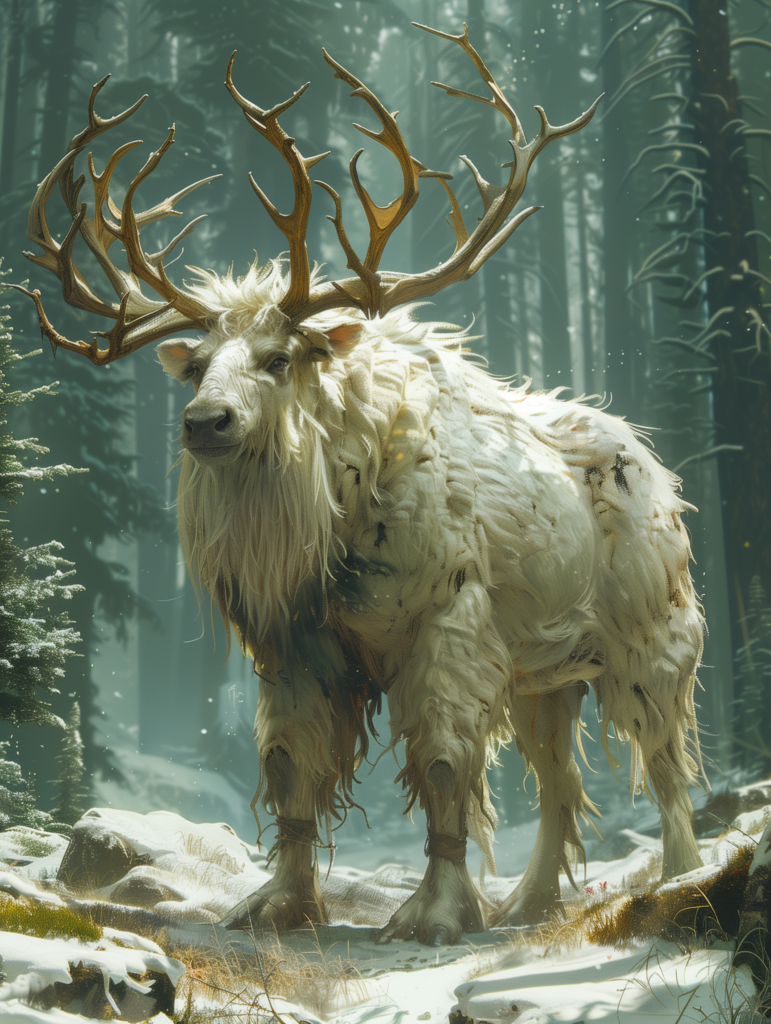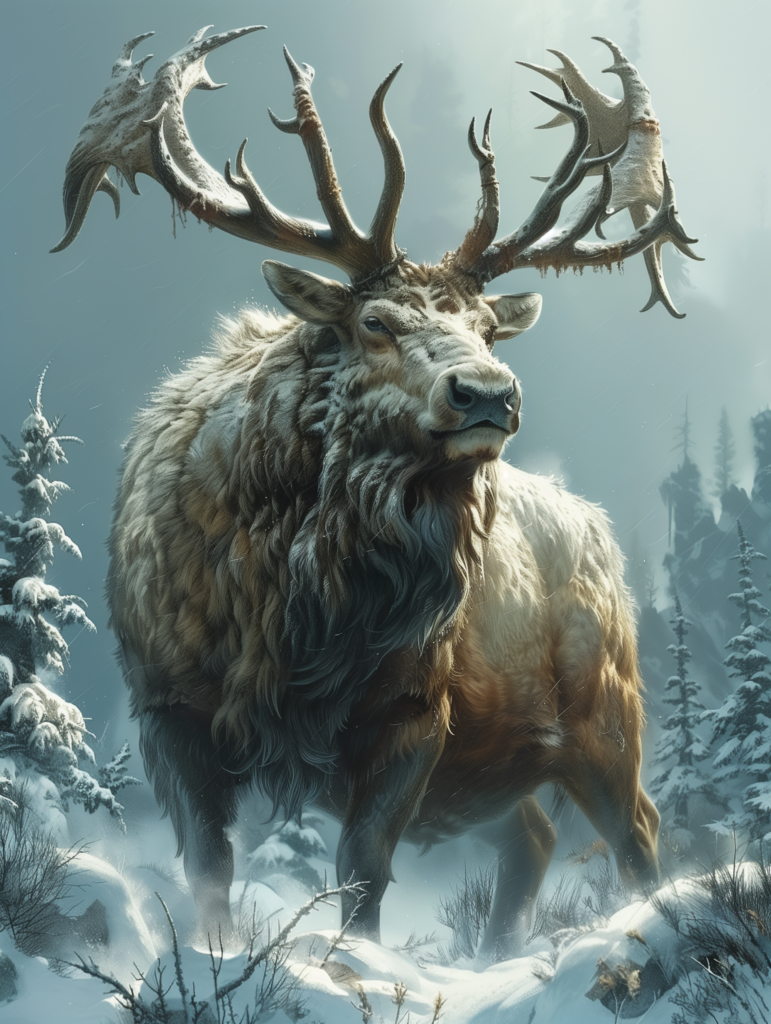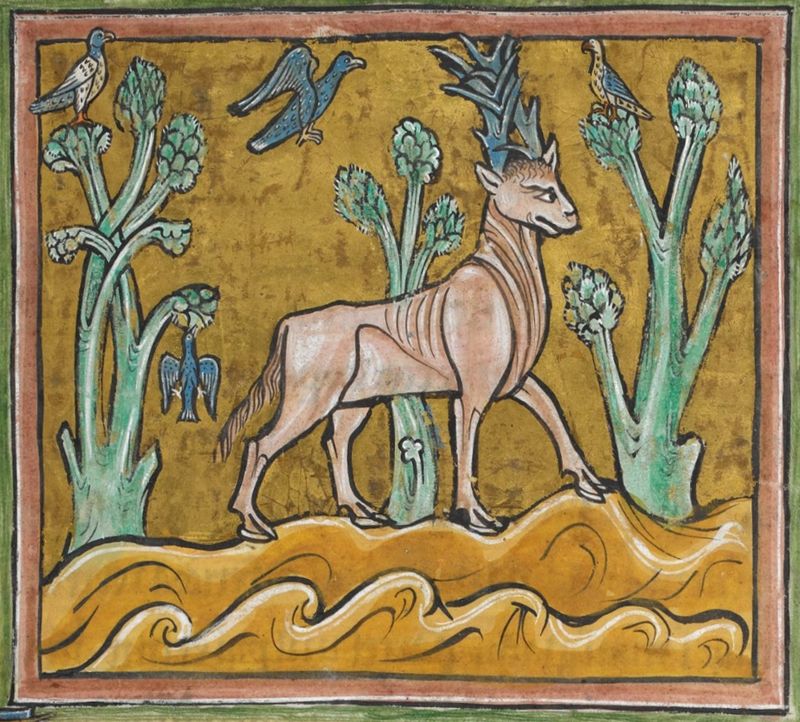Tarand
“Unveil the Mysteries of the Legendary Chameleon Beast – The Tarand: A Creature of Ever-Changing Wonders!”

Appearance: The Tarand is a majestic creature, resembling a hybrid of a reindeer and a moose, with a regal stature akin to an ox. Its head, reminiscent of a stag’s but larger, boasts impressive branched horns. Cloven-hoofed and covered in fur as dense as a bear’s, its back hides a tough and durable skin likened to steel armor. Its most captivating feature is its chameleon-like ability to change its hair and skin color to blend seamlessly with its surroundings.
Behavior: Highly elusive and adaptive, the Tarand is known for its cautious and skittish nature. It is a solitary creature, preferring the quiet solitude of remote, wooded areas where it can camouflage effortlessly. Despite its size, it moves with surprising agility and grace, often fleeing at the slightest hint of danger. However, when threatened, it can become aggressive, using its horns and hooves to defend itself.
Habitat: The Tarand inhabits diverse landscapes, from dense forests to vast, open plains, but it favors regions abundant in vegetation where it can easily blend in. It is commonly found in Scythia and other remote, mountainous areas, far from human civilization. Its chameleon-like ability allows it to thrive in various environments, making it a master of adaptation.
Modus Operandi: The Tarand’s survival strategy revolves around its unparalleled camouflage capabilities. It relies on its innate ability to change color to evade predators and remain undetected while foraging for food. When threatened, it uses its environment to its advantage, disappearing into the landscape like a ghost. Its elusive nature and enigmatic behavior have made it a subject of fascination and mystery for centuries.
Motivation: The primary motivation of the Tarand is survival. Its instinctual drive to blend into its surroundings and avoid detection ensures its continued existence in the harsh wilderness. Despite its natural prowess, it remains wary of potential threats and will go to great lengths to protect itself from harm. As a creature of mystery and wonder, it seeks only to live undisturbed in harmony with its environment.
Tarand 5e
Tarand 3.5
Tarand

Large beast, unaligned
Armor Class 14 (natural armor)
Hit Points 85 (10d10 + 30)
Speed 40 ft.
| STR | DEX | CON | INT | WIS | CHA |
|---|---|---|---|---|---|
| 18 (+4) | 14 (+2) | 16 (+3) | 2 (-4) | 12 (+1) | 7 (-2) |
Skills Perception +3, Stealth +4
Senses passive Perception 13
Languages —
Challenge 3 (700 XP)
Keen Smell. The Tarand has advantage on Wisdom (Perception) checks that rely on smell.
Chameleon Hide. The Tarand can change the color of its fur to blend in with its surroundings. While motionless and in a natural environment, it has advantage on Dexterity (Stealth) checks made to hide.
Charge. If the Tarand moves at least 20 feet straight toward a target and then hits it with a ram attack on the same turn, the target takes an extra 7 (2d6) bludgeoning damage. If the target is a creature, it must succeed on a DC 14 Strength saving throw or be knocked prone.
Actions
Multiattack. The Tarand makes two attacks: one with its horns and one with its hooves.
Ram. Melee Weapon Attack: +6 to hit, reach 5 ft., one target. Hit: 10 (2d6 + 4) bludgeoning damage.
Horns. Melee Weapon Attack: +6 to hit, reach 5 ft., one target. Hit: 8 (1d8 + 4) piercing damage.
Hooves. Melee Weapon Attack: +6 to hit, reach 5 ft., one prone target. Hit: 11 (2d6 + 4) bludgeoning damage.

What appears to be a deer the size of an ox stands before you. A long tail twitches behind it, and it is covered in long, glossy, black fur.
Used with Permission from Raymond_Luxury_Yacht of the Wizards Community forums.
The parandrus is a shy and reclusive animal that uses its natural ability to change its fur color to blend in with its surroundings.
The creatures are about 7 feet long, and weigh about 600 pounds. The long, branching antlers that crown their head can reach lengths of up to 3 feet.
Exclusively herbivorous, the parandrus dines mostly on mosses and lichen, although fungi and conifer leaves make up a small, albeit significant, part of their diet.
| Parandrus | |
|---|---|
| Large magical beast | |
| Hit Dice | 6d10+12 (45 hp) |
| Initiative | +2 |
| Speed | 40 ft. |
| Armor Class | 15 (-1 size, +2 Dexterity, +4 natural), touch 11, flat-footed 13 |
| Base Attack/Grapple | +6/+14 |
| Attack | Gore +9 melee (1d8+6) |
| Full Attack | Gore +9 melee (1d8+6) |
| Space/Reach | 10 ft./5 ft. |
| Special Attacks | – |
| Special Qualities | Chameleon, Darkvision 60 ft., Low-Light Vision |
| Saves | Fort +7, Ref +7, Will +2 |
| Abilities | Strength 18, Dexterity 15, Constitution 15, Intelligence 3, Wisdom 11, Charisma 9 |
| Skills | Hide +24, Listen +6, Move Silently +4, Spot +2 |
| Feats | Alertness, Run, Stealthy |
| Environment | Cold forests and mountains |
| Organization | Solitary |
| Challenge Rating | 3 |
| Treasure | None |
| Alignment | Always neutral |
| Advancement | (Huge) 7-12 HD (Large); 13-18 HD |
| Level Adjustment | – |
Combat
A parandrus is more likely to run and hide than fight, but will lash out viciously with its antlers if cornered.
Chameleon (Ex) A parandrus is capable of changing its fur color in a matter of seconds. This ability gives it a +15 bonus on Hide checks.
Skills The keen senses of a parandrus grant it a +4 racial bonus on Listen checks.

 Buy me a coffee
Buy me a coffee